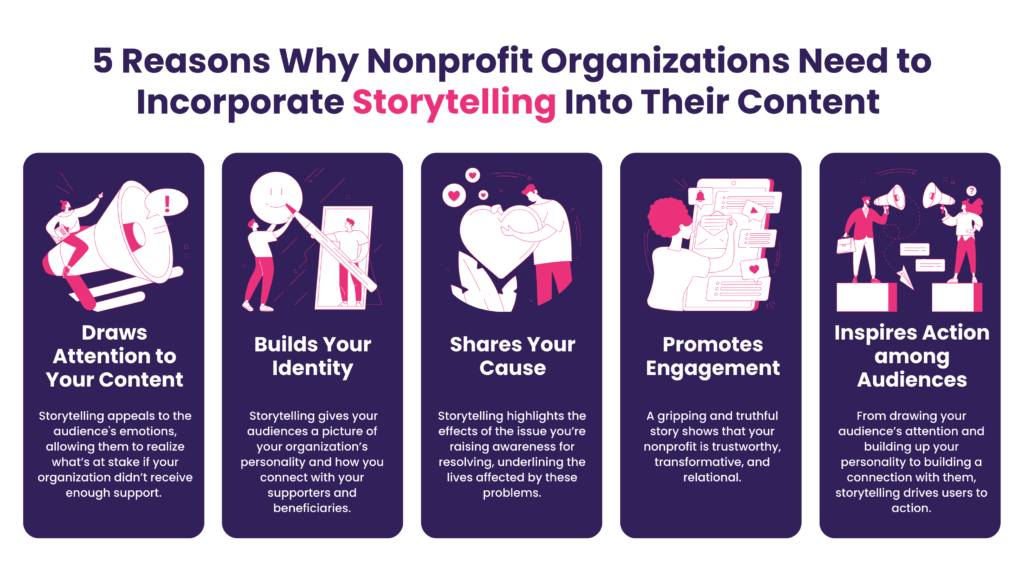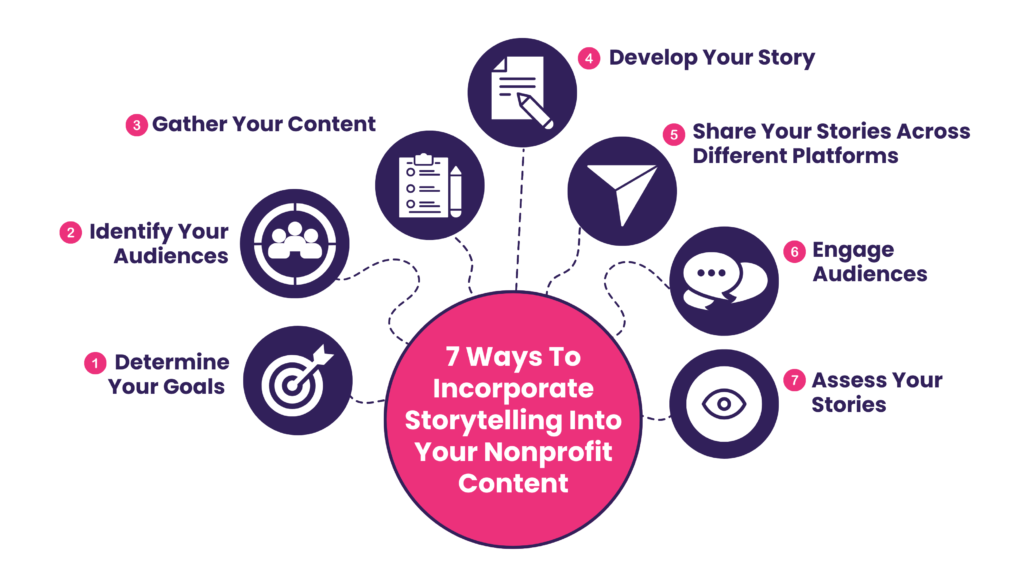Menu

Nonprofit organizations must keep their content as authentic and compelling as possible. With content marketing, nonprofit organizations connect to users and inspire them to give their time, donate, or support the cause. Since they rely their operations on volunteers and sponsors and don’t earn profit from their cause, nonprofits must also produce content that drives audiences to action.
It’s not easy to encourage anyone to donate time or money, so nonprofit organizations must employ the right strategies to inspire them to give. One of the ways to do this is to incorporate storytelling into your content. You can introduce the community you’re working with or the people behind your organization. This humanizes your organization and gives depth to your cause.

While nonprofit organizations campaign for different causes, they should all inspire audiences to join their cause and become donors or volunteers since they don’t really offer any product or service. Storytelling is one of the best practices to add depth to your content, giving it more impact. Nonprofit organizations might want to incorporate storytelling into their content because of the following reasons:
Nonprofit organizations campaign for great causes, but when boosting their online presence, they must make a bigger splash for audiences to find their site. Storytelling is one of the best practices you can do to draw attention to your content. This is because it appeals to their emotions, allowing them to realize what’s at stake if your organization didn’t receive enough support.
Storytelling builds the identity of your nonprofit organization. It gives your audiences a picture of your organization’s personality and how you connect with your supporters and beneficiaries. These vibrant accounts prove your commitment to your mission and values and how you execute them. Audiences will be encouraged to join your cause, even on a personal level if they get to know more about you.
Your nonprofit can also set itself apart from others with stories about the organization. Storytelling tells users why your nonprofit is unique from other organizations in your field or industry – this can demonstrate your expertise, origin, direction, and foundation.
Many audiences may have surface-level knowledge of your cause, but it takes vivid stories, updates, and shocking statistics to develop a deeper understanding. It highlights the effects of the issue you’re raising awareness for resolving, underlining the lives affected by these problems. This appeals to the audiences’ emotions and allows them to empathize with the community you’re working with, inspiring action.
Storytelling promotes engagement and encourages a strong relationship with your nonprofit organization and supporters. A gripping and truthful story shows that your nonprofit is trustworthy, transformative, and relational, so their donations and support wouldn’t go to waste if they support your organization.
Audiences can feel a connection to your content if you incorporate a storyline. Once your nonprofit has built and maintained relationships like these, it can greatly elevate your organization.
From drawing your audience’s attention and building up your personality to building a connection with them, storytelling drives users to action. They can give you their time and provide donations as you evoke their emotions and establish a relationship with them. This can also promote retention and set your organization up for success in building an online community of supporters.

Storytelling is vital for your nonprofit, as it draws audiences in, establishes a connection, and inspires them to act for your cause. To incorporate storytelling into your content, you can check out the following ways:
You must first determine your goals when building and publishing a story. Get back to determining your content marketing campaign’s overall goal. From here, you’ll get a better idea of choosing your story. Your goal may be any of the following:
Once you’ve developed your story with a winning call-to-action, the audience should be able to convert it into your desired action, contributing to your goals.
Before cooking up a story, consider your audience first. They may be diverse, from volunteers and advocates to board members and donors. Individuals within these categories fall into varying ages, gender, and even methods of communication. Because of this, it’s just right to create different stories suitable for each type of audience or have the main story with different framing. This allows you to appeal to each persona.
Before commencing your storytelling, you might want to prepare your arsenal. Gather your content or the stories you’d be featuring. You’ll get these stories from your constituents, staff or volunteers, and donors. Organize your content library, which will include:
You can easily incorporate storytelling with your content marketing calendar and map it across various platforms to reach your audiences efficiently. Planning your storytelling is necessary because content can be evergreen or seasonal – you might not want to waste your content by uploading it at the wrong time.
Storytelling requires a logical flow or framework for audiences to follow the turn of events. How you weave stories together is necessary for the appeal of your stories and how you evoke strong emotions in users. To develop your story, you must:
Choosing the right character motivates audiences to do an action. But you might also want to be mindful and responsible for featuring the stories of the people around your organization, especially with constituents. You may want to highlight their calls and needs without misrepresenting or seemingly taking away their agency.
Consider having multiple channels for your storytelling strategy. Share your story across different platforms to reach a broader audience. This allows it to retain your audiences and encourage action. You can upload this in your:
Prioritize the platform where your audience engages with you the most. You can determine this by tracking your history of posts, fundraising campaigns, and other initiatives. Identify which is the most popular.
Your story doesn’t stop at being heard – it must inspire action. Invite your audiences to join your cause by donating, volunteering, or simply spreading the message by sharing. Your story won’t be complete without a strong CTA that drives them to the next step.
Like with all of the tasks in your content marketing strategy, you must track and assess your performance to spot any hiccups. This shows how well your audiences have received your storytelling strategy. Some of the metrics to look at are the:
If your data comes back with underwhelming results, you may want to revert to your strategy, determine roadblocks, and clear them. You can tweak its wording, dissemination, or tone to evoke emotions.
Nonprofits can incorporate storytelling into their content marketing strategy to build a strong identity, provide depth to their cause, attract audiences, and inspire action. It encourages audiences to join your cause.
To have a storytelling strategy for boosting online presence, nonprofits should define their campaign goal. They should prepare by determining their audiences and gathering their content. They can now develop their story by framing their story arc, introducing their characters, depicting the conflict, and introducing the solution. Nonprofits should publish their story on different platforms, engage with audiences, and assess their performance.
